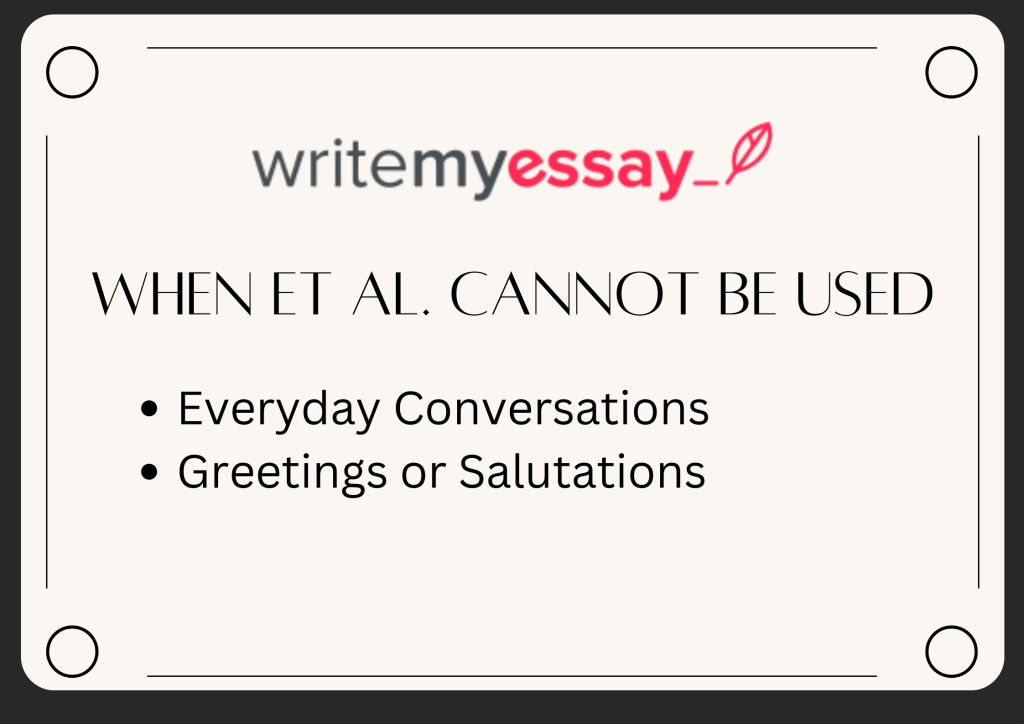
The Ultimate Et Al. Guide

Table of Contents
When it comes to academic writing, there are certain rules and regulations that writers need to follow. They may seem a lot of hassle when they are working, but they contribute a lot to the overall value and quality of the essay or a paper. One of the most common things in this regard is the writing style.
Every style guide has its own set of rules. Among them, you would often find terms and phrases from other languages, such as Greek and Latin, to denote something. Some of the most common examples include e.g., i.e., etc., and et al. These are all Latin abbreviations to quickly hint at a thing before moving on.
In this post, we will cover the meanings of et al., its correct usage, and cases. You will learn how to write et al. in your essay or paper.
Meanings of Et Al.
The term “Et Al.” is made up of two words, one of which has been shortened to better suit the needs. The two words “et” and “al.” stand for “el alia” which means “in addition to” or “and others”. With the literal meanings out of the way, we know that they can be used in place for different things, such as the names of the authors or characters. By using et al., you can write one name and then place this and the readers will know that other authors contributed to the writing of a work.
However, it should not replace a single name but many. For instance, if there are only two authors who had written a book, you cannot use et al. in that case. But if there were many, you can write the name of the first author and then place et al.
Using The Correct Punctuation For Et Al.
After going through the meanings and simple usage of the term, let us go through the correct punctuation of the term before we get to place it in a sentence. The rules suggest that the part “et” should not be followed by a period because it is a complete work in itself. On the other side, “al.” must be followed by a period because it is itself a short and convenient form of “alias.”

The following et al. usage is wrong:
- Et. Al.
- Et. Al
- Et Al
Contrary to this, this is the only right way to cover the term:
- Et Al.
In addition to this punctuation of the term, there are other rules of writing that writers and scholars need to keep in mind.
At The End of A Sentence
Since the “al.” part is always succeeded by a period, there is no need to add another period if the “et al.” part is finishing the sentence. For instance, each Zodiac sign has its pros and cons, as illustrated by Hancock et al.
At The End of A Phrase
When the “et al.” part is finishing a phrase, there is no foul in adding a comma after the period of the “al.” part. Indeed, it is a norm among scholars that must be followed. Example: (Hancock et al., 2010)
With Oxford Comma
The Oxford Comma is a pre-conjunction comma that is used before the last part of the list. As you can use a comma after et al., you can surely use a comma before it without any issue.
When you are using Oxford Comma:
Hancock, Carson, et al.
When you are not using Oxford Comma:
Hancock, Carson, et al.
Comparison Between Et Al. & Etc.
Like all similar-looking things in the writing, many students make the mistake of using et al. in place of, etc., and vice versa. Both are Latin terms and are commonly used in sentences to cover more than one item in a list. We have already covered the meanings of et al., so let us go through the meanings of, etc.
It is an abbreviation of et cetera which means “and the rest”. Like the et al, it is used when writers do not want to or need to mention all the things in the list. However, etc. can be used for anything, such as objects, ideas, places, and more, except people. We cannot denote different people through the use of etc. This is where et al. come into the picture.
Here are examples for both to clear any confusion:
- John bought spices, salt, sugar, etc. to make the dinner
- People in the Stone Age used rudimentary tools to fend for themselves, according to Hancock et al.
Ambiguity in The Usage of Et Al.
Although et al. is used to bring more clarity to the text instead of more confusion, there could be instances when that becomes the case. While writing on and referencing books, there can be cases when books have similar authors with a little change to the credit list. On top of that, if these books had the same publishing year, it can mislead researchers and ambiguity reigns supreme.
Say you want to reference two books, named Before and After. The former was authored by John Carson, Randall, Hancock, Joseph Rogan, and David Goggins, whereas the latter was written by John Carson, Randall, Hancock, Joseph Rogan, David Goggins, Andrew Shulz, and Kevin Hart. Both were published in 2009.
If you write “Carson et al. (2009)”, it will not make things clearer as to which book are you referring to. Instead, the citation will go like this:
Carson, Hancock, Rogan, and Goggins (2009)
Carson, Hancock, Rogan, Goggins, et al. (2009)
We did not use et al. in the first reference point because there were no authors left to cover in the term. In the second case, we had the names to cover, and et al. neatly bundled them up.
Using Et Al. In APA Writing Style
APA writing style was developed by American Psychology Association and is considered to be the best and most widely-used style in Social Sciences. Here are the rules with et al. examples to use in the in-text citations of an APA essay or paper.
- When a book is authored by up to two writers, you will write the last names of the two like this. One author: (Chandler, 2012). Two authors: (Ross & Chandler, 2015)
- If a text is written by multiple authors, write the name of the first author and then use et al. to cover the rest. (Hancock et al., 2009)
- The earlier versions of APA suggested that if three to five authors have worked on a text, the first citation should carry the last names of all authors whereas the rest should name the first author followed by et al. First citation: (Carson, Hancock, Rogan, Goggins, & Shulz, 2009). The rest of the headings should look like this: (Carson, 2009)
Using Et Al. In MLA Writing Style
Modern Language Association or MLA writing style is the most popular among Arts and Humanities subjects. It is often regarded as the most flexible and versatile writing style with almost no rigid areas. While citing authors of a book, both in-text and bibliography citations are as follows:
- The in-text citation looks like this: (Carson, 2009)
- The bibliography entry for the book should look like this: (Carson, et al. Before. 2009)
Using Et Al. In Chicago Writing Style
The Chicago writing style is different from the rest of the guides because it can use footnotes, references, as well as in-text citations. Using Chicago Manual, you can use et al. for books and articles that have at least four authors. In case you are not making a dedicated bibliography in the end, you can take advantage of the footnotes option.
- The in-text citations should look like this: (Carson et al., 2009, 32-33)
- In footnotes: first mention: Carson et al., Before (2009), 34-39. The rest of the mentions should look like this: Carson et al., Before, 30-33
- In the bibliography, here is the correct way of using et al.: Carson, Hancock, Et al., Before. 2009
Using Et Al. In Harvard Writing Style
The Harvard citation style, at least in this case, is one of the most straightforward. The style guide suggests that if a work has three or more authors, you can write the last name of the author and then place et al. to denote others. Here is an example from Harvard reference style:
- (Carson et al. 2009)
What Is Et Alibi?
As mentioned in the earlier sections of the post, the term “et al.” is a short form of the term “et alia”. In the same manner, et al. has more than parent terms. One of which is et alibi. Usually, an alibi is used in criminal cases where suspects need to confirm their location away from the crime site to get out of the suspects’ list.
- Etc. refers to things and objects
- Et alia refers to people
- Et alibi refers to places
In academic writing, et alibi is used to refer to places and locations, both real and virtual. For instance, if you went on a family trip around India, you can sum up all the locations by mentioning the most significant ones.
- We went to the Taj Mahal, India Gate, et al. to understand the past and present of India
- For the cases when you are referring to virtual places, you can also use the term et alibi like this: The author used Latin terms (page 34 et al.) throughout his work.
Guidelines For Using Et Al.
In this section, we will cover the usage of et al. according to the occasion. When you are writing an academic paper through references, it is always best to reference the sources to ensure that your text is unique and perfectly referenced to avoid plagiarism.
There are two major categories of usage: formal and informal.
Formal Usage of Et Al.
Formal usage covers essays, papers, assignments, and reports that you might have to prepare and then submit for evaluation. We have extensively covered the aspect of referencing authors in the previous sections, but you can also use this style to cover characters.
For example, if John Carson, Randal Hancock, Joseph Rogan, and David Goggins wrote a book called, The Art of Lying, you can reference that book in your text as follows, using et al.:
Carson et al. researched the nature and ways of how people lie in The Art of Lying.
It does not matter whether you are writing a full-length dissertation or a class essay, you will save a lot of time and hassle by bundling the names together in a clean term.
With Characters In A Book
When you are writing a book or poem summary that has many characters, you can divide them into any of two or three categories and use et al. to denote one group.
For instance, all the righteous people joined hands together and stood with Indiana Jones to fight demons.
Informal Usage of Et Al.
Let us make one thing clear: et al. is a formal term and is used most of the time in that setting. However, some of the informal instances are perfect to showcase the versatility of this term.
Emails are the perfect places where you can use the term “et al.” in the informal setting. For instance, if you are describing something that involves more than three or four people, you can save a lot of time by resorting to this. Here is an example:
- Brock, Jones, et al. went to the arena to watch the fight
When Et Al. Can’t Be Used
The formal nature of the term hinders its usage across everyday scenarios. Imagine using this term while talking with your friends!
Conversations
Normal conversations do not require this term to bundle up different people. You can use different terms such as group, squad, and more to cover for it.
Salutations
The same goes for salutations and greetings. You never say “greetings, Mr. President et al. Rather, you can take advantage of the informality and use terms like “hello everyone” or “greetings to all” to give the effect.
Summing Up The Discussion
It is safe to summarize that et al. is a great tool for students and scholars to make the process of writing papers and essays easier and hassle-free. In this resource, we have covered different elements and areas around et al., including use cases, nature, similar terms, and more. We hope that students will find the most helpful in understanding the term better and use it in their essays and papers.
For writers who cannot write themselves, Write My Essay is a leading brand that offers exceptional academic writing services. Whether you need a custom essay or an original paper, you will always find us to be at the top of the game. So, place your order now and enjoy excellent rewards!


